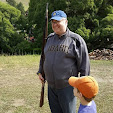John, for whom I am painting these large Napoleonic armies, requested a look at my process. I think that is a great idea! Get ready for way too much detail about how I take the figures from raw lead to based armies.
All of these pictures are of my actual working area. I did not clean or even tidy it up too much, so you will see coffee mug rings, glue stains, various paint flakes, etc. I work at this space every day for at least three hours. It is a well lived-in space, and these pictures reflect that.
To my left I have a tall bookshelf that I built myself. The top two shelves are committed to storing my various commissions. Most of this stuff is for Carl's Weird War II project (more to come). The two plastic bins to the left are labelled "John Maguire French" and "John Maguire British." The stack of papers between the two bins contains all my typed notes on the project.
This is my workspace. To the left are some shelves holding Vallejo paints, brushes, some glues, and figures in various states of completion. To the right is my revolving carousel of craft paints. The computer entertains me while I paint, either with YouTube videos, Great Courses lectures, or audiobooks.
The papers here list the contents of John's French army by unit and figure codes. When the figures arrived from Eureka USA, I counted them, checked for any damage, and sorted them by unit. Here we have the Old Guard grenadiers and chasseurs.
I usually just use a hobby knife to cut casting marks off the figures. I make sure they stand upright and don't have any obvious flaws. I will clean flash from between legs, but I won't rescuplt the figure. Fortunately, AB Miniatures are always well cast.
My friend Austin got me started replacing the soft metal flagpoles on all my figures. Now I do this on all my commissions as well. It is laborious, but it makes for much more robust command stands. I cut the existing flag pole from the figure, use a pin vise to drill holes in hands and eagle, and cut brass rod to size. Super glue works just fine to keep the flagpole in place.
France's Old Guard is sorted by pose and ready for the next step.
I have read that I am wasting my time by washing the figures, but I find this step absolutely necessary. The casting process always results in a thin residue. Hot water, a mild dishwashing soap, and gentle agitation seem to do the trick. Before I started washing my figures, I frequently had paint rub away from the bare metal. Since I started washing, I have never had rubbing or flaking.
I will be painting the whole French Guard infantry, 468 figures, at one go. I know many painters who base figures individually for painting. I find that basing them on temporary painting sticks makes it much easier to paint in quantity. I use wide popsicle sticks and Elmer's Glue-All.
I always label the underside of the sticks so I know whet I am painting. Sure, I can tell an unpainted French line fusilier from a guard grenadier, but I cannot always tell a grenadier from a chasseur at a glance.
I sort the infantry by pose and glue six figures per stick. The Glue-All provides a solid enough bond that the figures do not fall off during painting, but the bond is weak enough that I can remove the figures with my hands when they are done.
Once the glue cures (usually overnight), these figures are ready for priming. Here we have two battalions each of Old Guard grenadiers and chasseurs, plus skirmishers.
I hope this was of some use. I know I always enjoy seeing other painters' techniques. Tomorrow I will document my priming process.
















































































